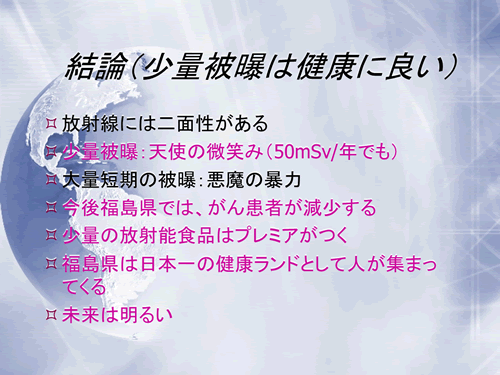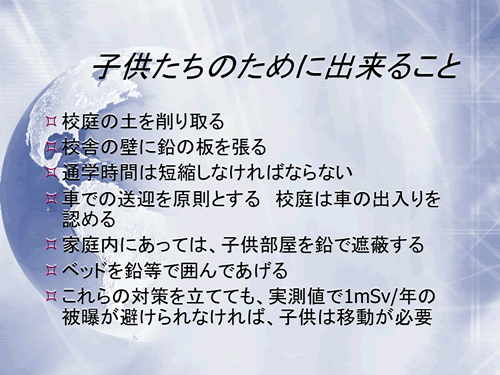I thought I was reading Yomiuri or Asahi or the Japanese government's press conference transcript back in March and April.
But no, this is a June 29 Des Moines Register editorial, telling readers "Don't be irrational, don't be hysterical, and don't you dare be anti-nuke". And don't listen to those "baseless rumors":
Nuclear plants need scrutiny, not hysteriaI particularly like the last three paragraphs."Right now the plants are safe."
That's what the chairman of the U.S. Nuclear Regulatory Commission said of the two nuclear power plants along the Missouri River in Nebraska after recent flooding. There have been no "nuclear releases." Vital systems to ensure safety are protected. Flood waters are not expected to become unmanageable.
Gov. Terry Branstad said that state officials are monitoring the plants and that the public should not worry.
Yet some people worry.
People worry because just the phrase "nuclear power plant" conjures thoughts of Chernobyl and Three Mile Island. People worry because the world is still watching as Japan deals with the Fukushima nuclear power plant from both a human health and economic perspective.Iowans worry because the Nebraska plants are separated from us by only a river rather than the Pacific Ocean.
A healthy dose of concern about nuclear energy is necessary to help keep this country's power plants are safe. The United States must remain dedicated to rigorous scrutiny of plant safety regulations and emergency measures.
Yet the public's concern should not be irrational or used to feed an anti-nuclear energy agenda or imply that the U.S. government is lying to Americans.Unfortunately, that's exactly what is happening online where anything goes and supposed reporters aren't held accountable for blatant misinformation. One online newspaper in Pakistan reported that a Russian nuclear energy agency has obtained information about an accident at one of the Nebraska plants. It stated President Barack Obama ordered media not to report the accident and imposed a "no-fly" zone over the plant because of radiation leaks.
"The rumors have been as difficult to combat as the rising floodwaters," said the spokesman for the NRC.The situation in Nebraska -- like the situation in Japan -- is an opportunity to learn and inform conversations about nuclear energy.
This country has 104 nuclear power plants in 31 states, including Iowa. What's going on in Nebraska is a reminder of the need to ensure they are safe and there are plans in place to respond in the event of a natural or man-made disaster.
They are also a reminder of the importance this country must place on protecting key areas -- including those with nuclear plants -- from flooding.While the U.S. must continue to focus on conservation and cultivating alternative sources of energy like wind, the reality is nuclear energy provides 20 percent of the nation's electricity. Along with coal, petroleum, natural gas and wind, it is an important part of this country's energy portfolio.
That portfolio must be more, not less, diverse. As the world has seen in Japan, a disrupted energy supply can lead to an economic crisis.
Americans use a lot of energy. It has to come from somewhere, and providing it comes with risks. Yet we do not stop drilling for oil because there is an oil spill. We do not stop mining for coal because of a cave-in.We cannot allow fears about nuclear energy -- unfounded fears, as of now in Nebraska -- scare us away from this important power source.
A disrupted energy supply in Japan is not because of nuclear power plant shutdowns, but because too many thermal and hydro power generating plants had been shut down. Rolling blackouts were intentional, to teach the Japanese the lesson - "nuclear power is necessary". Besides, an economic crisis is the last thing that ordinary people in Japan care about right now. (I don't know about the politicians and big power company execs.)
So you don't stop drilling for oil because there's an oil spill. You do not stop mining for coal because of a cave-in. So you don't stop nuclear power generation just because a nuke plant has 3 meltdowns and releases 800,000 terabecquerels of radioactive iodine, cesium, strontium, plutonium, and poison the countryside and waterways and sicken the population for decades. That's such a small price to pay for a growing economy, according to the editor of the paper.
Unfounded fears?
This can't be written by an American in America. This has got to be written by Yomiuri... It's started to feel like a "Groundhog Day"...

















 Tokyo Time
Tokyo Time
![[Most Recent Quotes from www.kitco.com]](http://www.kitconet.com/charts/metals/gold/t24_au_en_usoz_2.gif)

